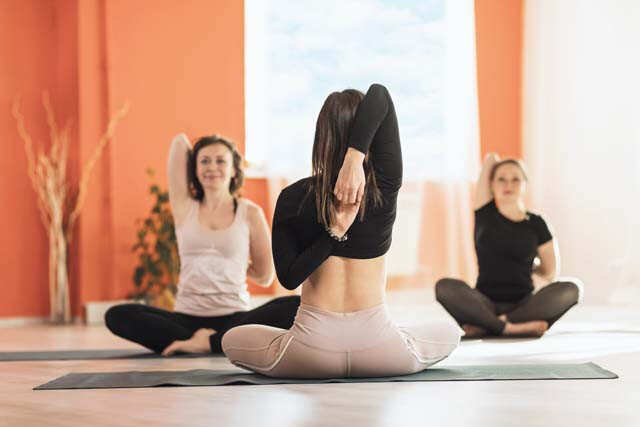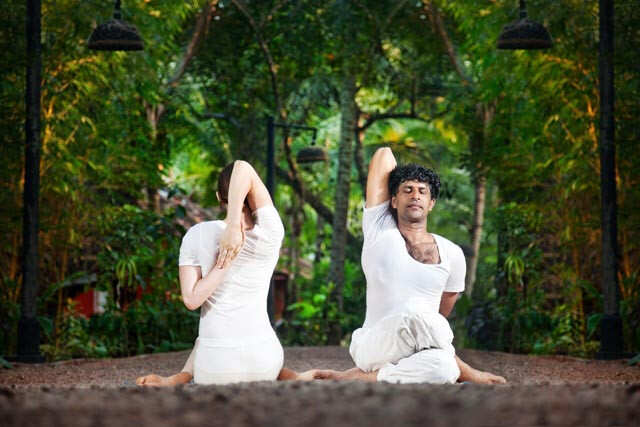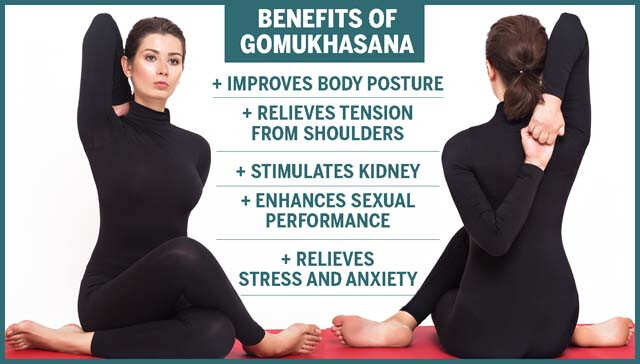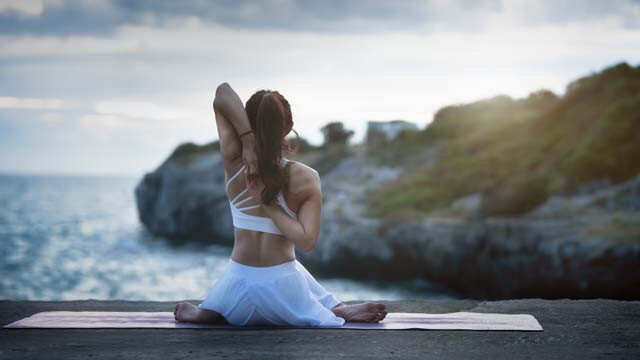
Image: Shutterstock
Yoga is the art of harmonising the body, mind and soul. It also reigns as the most trusted and effective method of nourishing and toning one’s body in a holistic sense. Asana is a Sanskrit term that means ‘posture’ or ‘pose’, which provides several health benefits such as flexibility, increased blood flow, boosting immunity and builds muscle strength. One such asana is Gomukhasana, also known as cow-face posture because the body resembles the face of a cow when in this position. It is a seated yoga posture that helps stretch the arms, triceps, shoulders and chest. This asana is therapeutic and can help release tension from the shoulders and hips.

Image: Shutterstock
How To Do Gomukhasana?
Precautions Before Practising Gomukhasana
Health Benefits Of Gomukhasana
Gomukhasana FAQs
How To Do Gomukhasana?

Image: Shutterstock
Step 1: Sit erect on the ground with your legs stretched out, preferably in Dandasana.
Step 2: Now bend your left leg and place it under the right buttock. It is advisable to come forward onto your hands and knees to do this.
Step 3: Bring the right leg over the left thigh.
Step 4: Place both the knees close together as they are stacked one top over the other. Bring the heels equidistant from the hips with the right heel closer to the left hip.

Image: Shutterstock
Step 5: Separate your feet and come back to sitting evenly between the sitting bones.
Step 6: Take in a deep breath and bend the left elbow: bringing the left hand to the back of your neck- fold the arm upwards, palm facing outwards.
Step 7: Stretch the right hand to the right side, bend the elbow and bring your arm behind your back.
Step 8: Stretch your right arm as much as you can until it reaches your left hand. With practice, you will not only be able to reach the left arm but also be able to catch hold of it.
Step 9: The trunk must be erect and the body should lean slightly back. Take deep and even ujjayi breaths and stay in the position for as long as you are comfortable (preferably less than 60 seconds for beginners, less than 120 seconds for intermediate and more than 120 seconds for expert). Concentrate on your breathing.
Step 10: Release your arms on an inhale, uncross the legs and repeat with the other arm and leg for the same length of time.
Tip: Beginners usually find it difficult to get into this position and rest evenly on the floor (the spine cannot extend itself when the pelvis is tilted), so it is advisable to use a blanket or a bolster as support until the practitioner is being able to do it comfortably.

Image: Shutterstock
Precautions Before Practising Gomukhasana
- If you are experiencing severe shoulder pain, calf injuries, neck problems or backache, refrain from doing the Gomukhasana. If the pain is mild, do consult a doctor before doing this asana.
- In the case of tight shoulders which hinder you from clasping your fingers behind your back use a strap between your hands. Drape the strap over your shoulder of the lower arm and then catch the other end of the free strap with your upper arm. Keep trying this till you are comfortably able to do this asana with no additional prop.
- It is best if this asana is performed first thing in the morning. Make sure you have your meals at least 10 to 12 hours before your practice which will give numerous health benefits.
- Most importantly avoid straining the body beyond the limits as it may cause some serious injury.
Tip: Any complicated asana must be performed under the supervision of a specialized yoga trainer. It is also thoroughly important to keep all your health conditions in mind before practicing any asana.

Health Benefits Of Gomukhasana

Image: Shutterstock
Improves Body Posture: Gomukhasana stretches muscles in the ankles, knees, chest and shoulders which not only strengthens them but also improves the overall body posture. During the asana, almost all body joints are in operation which increases blood flow and ensures the body gets more blood and nutrition. In the long run, it prevents injuries in the ankles, chest, back and shoulder.
Cures Sciatica Infection: Sciatica is a term used to describe nerve pain in the leg that is characterized by the compression and irritation of the sciatic nerve which originates in the lower back, passes through the buttock and travels down the leg. Gomukhasana can cure or keep away such pain by lengthening and stretching the spine.

Image: Shutterstock
Stimulates The Kidney: Gomukhasana is one of the best asanas for helping in the smooth functioning of the kidney. A study has also proved that it reduces the formation of stones in the kidney. It also improves the frequency of urination flushing out all the toxins, acids and other unwanted materials.
Enhances Sexual Performance: Many yoga instructors have suggested that to keep your sexual life healthy, you must practice Gomukhasana regularly. This asana squeezes our sex organs which helps in the production of sex hormones, improves blood and overall increases sexual performance. It also strengthens the hips, calves and thigh muscles which are optimal body parts for good sexual performance.

Relieves Stress and Anxiety: Everyone is leading stressful lives juggling work and personal life. Gomukhasana is one of the best ways to get relaxation from stress. It is the perfect combination of physical and mental practice that lowers blood pressure and heart rate - the main symptoms of stress. The slow and rhythmic pattern of breathing followed by any yoga practice brings a sense of calmness to the mind.
Tip: Gomukhasana is highly beneficial for your health and must be practiced regularly to see the changes in your body.

Gomukhasana FAQs
Q. Are there variations to Gomukhasana?
A. There are a few variations and modifications to Gomukhasana in case of any pain or injury. If you have stiff shoulders, you could simply place your arms by your sides. Another variation (stated above) is placing a strap between your arms. A third variation is to place a cushion or a blanket below to soften the intensity in the hips. A common variation for beginners is doing the pose without the arms fold to just focus on the hips.
Q. What should be the preparatory poses of Gomukhasana?
A. There are a few preparatory poses of Gomukhasana that will open the shoulders and hips, but they should be followed in proper order. It should begin with 10 rounds of Surya Namaskar (Sun Salutation) because they open up the arms, shoulders and lower back. Then Baddha Konasana (Bound Angle Pose) must be followed which will open the thighs and the knees. The longer you can stay in the position, the easier Gomukhasana will be for you. Finally, Dhanurasana should be done which will ease up the chest, legs and shoulders.

Image: Shutterstock
Q. Is cow-face pose beneficial for frozen shoulders?
A. Although a slightly difficult asana, Gomukhasana is very beneficial for a person with a frozen shoulder- it can eliminate stiffness and reduce tension, and help gain mobility. It might hurt initially but eventually has promising results. To get a wholesome benefit, it is recommended to also do Garudasana and Dhanurasana along with Gomukhasana. This should strictly be done under proper supervision or else could lead to worse pain.